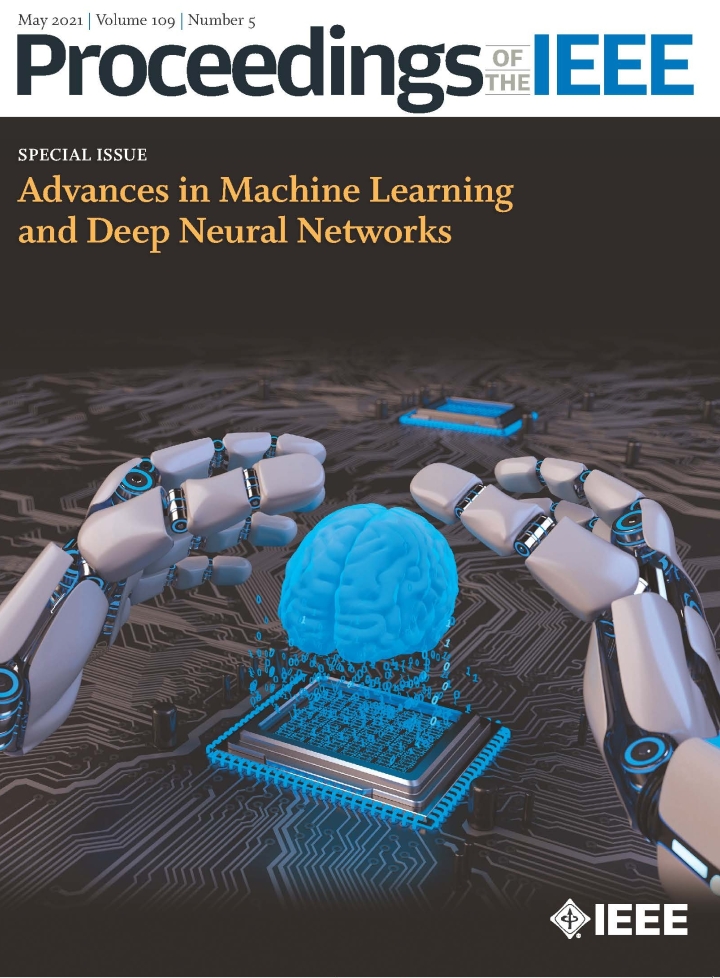2021 Journal Issues May 2, 2021


Special Issue: Advances in Machine Learning and Deep Neural Networks
Volume 109, Issue 5
May 2021
Guest Editors
Guest Editors: Rama Chellappa, Sergios Theodoridis, and Andre van Schaik
Special Issue Papers
By R. Chellappa, S. Theodoridis, and A. van Schaik
By B. Schölkopf, F. Locatello, S. Bauer, N. R. Ke, N. Kalchbrenner, A. Goyal, and Y. Bengio
This article reviews fundamental concepts of causal inference and relates them to crucial open problems of machine learning, including transfer learning and generalization, thereby assaying how causality can contribute to modern machine learning research.
By G. Ortiz-Jiménez, A. Modas, S.-M. Moosavi-Dezfooli, and P. Frossard
This article presents an in-depth review of the field of adversarial robustness in deep learning and provides a self-contained introduction to its main notions.
By L. Ruiz, F. Gama, and A. Ribeiro
This article deals with graph neural networks (GNNs) that operate on data supported on graphs.
By C. Fang, H. Dong, and T. Zhang
The focus of this article is on theoretical developments concerning the analysis of overparameterized neural networks.
By R. Balestriero and R. G. Baraniuk
In this article, the bridge between deep networks (DNs) and approximation theory via spline functions and operators is rigorously established.
By P. Maragos, V. Charisopoulos, and E. Theodosis
This article deals with tropical geometry that has recently emerged as a tool in the analysis and extension of several classes of problems in both classical machine learning and deep learning.
By L. Ruff, J. R. Kauffmann, R. A. Vandermeulen, G. Montavon, W. Samek, M. Kloft, T. G. Dietterich, and K.-R. Müller
This article deals with application of deep learning techniques to anomaly detection. Furthermore, connections between classic “shallow” and novel deep approaches are established, and it is shown how this relation might cross-fertilize or extend both directions.
By J. Park, S. Samarakoon, A. Elgabli, J. Kim, M. Bennis, S.-L. Kim, and M. Debbah
The goal of this article is to provide a holistic overview of relevant communication and machine learning (ML) principles, and thereby present communication-efficient and distributed ML frameworks with selected use cases.
By S. K. Zhou, H. Greenspan, C. Davatzikos, J. S. Duncan, B. van Ginneken, A. Madabhushi, J. L. Prince, D. Rueckert, and R. M. Summers
In this article, the authors highlight both clinical needs and technical challenges in medical imaging and describe how emerging trends in deep learning are addressing these issues.
By M.-Y. Liu, X. Huang, J. Yu, T.-C. Wang, and A. Mallya
This article provides an overview of generative adversarial networks (GANs) with a special focus on algorithms and applications for visual synthesis.
By Y. Panagakis, J. Kossaifi, G. G. Chrysos, J. Oldfield, M. A. Nicolaou, A. Anandkumar, and S. Zafeiriou
This article provides an overview of tensors and tensor methods in the context of representation learning and deep learning, with a particular focus on visual data analysis and computer vision applications.
By K. Somandepalli, T. Guha, V. R. Martinez, N. Kumar, H. Adam, and S. Narayanan
The topic treated in this article is the application of deep learning algorithms, combined with audio-visual signal processing, to analyze entertainment media such as film/TV.
By M. Davies, A. Wild, G. Orchard, Y. Sandamirskaya, G. A. Fonseca Guerra, P. Joshi, P. Plank, and S. R. Risbud
This article provides a survey of results obtained to date with Intel’s Loihi across the major algorithmic domains under study, including deep-learning approaches as well as novel approaches that aim to harness the key features of spike-based neuromorphic hardware more directly.
By F. Zenke and E. O. Neftci
This article provides a mathematical framework for the design of practical online learning algorithms for neuromorphic substrates.